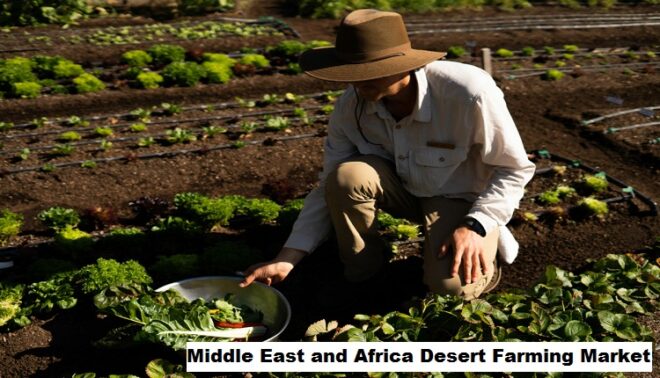
The Middle East and Africa Desert Farming Market is expected to grow during the forecast period of 2024-2028, driven by increasingly dry and depleting climatic conditions.
According to TechSci Research report, “Middle East & Africa Desert Farming Market– Industry Size, Share, Trends, Competition Forecast & Opportunities, 2028F”, the Middle East & Africa desert farming market is stood at USD 65.56 million in 2022 and is anticipated to grow with a CAGR of 5.71% in the forecast period 2024-2028. This is attributed to the growing demand for food security in the Middle East & Africa. Therefore, desert farming can offer an alternative for farmers that are experiencing more frequent droughts and extreme weather patterns.
Additionally, the high dependence on imported foods can be reduced by practicing desert farming, which can help to have more access to fresh, and healthy foods, thus, in turn, augmenting the growth of the Middle East & Africa desert farming market. Advances in technology, such as solar-powered irrigation systems and hydroponic techniques, are making desert farming more feasible and efficient, which is expected to further aid the growth of the Middle East & Africa desert farming market in the future five years.
Hydroponics is one of the most notable trends in desert farming which involves growing plants in nutrient-rich water solutions, which eliminates the need for soil and reduces water usage. This method is particularly well-suited for growing high-value crops such as tomatoes, cucumbers, and lettuce in the desert region of Middle East. Hydroponic systems is also used to grow crops in controlled environments, using artificial lighting and climate control systems, which allow for year-round production.
A0nother trend which is boosting the practice of desert farming includes vertical farming which involves growing crops in vertically stacked layers, using artificial lighting and climate control systems. This method allows for the efficient use of space and resources and can be used to grow a variety of crops in urban areas with limited access to arable land. In addition, vertical farming can be used to produce crops close to the point of consumption, reducing transportation costs and greenhouse gas emissions.
Moreover, advancements in genetics and plant breeding have also contributed to the development of crops that are better suited to arid regions. Plant breeders are developing crops that are more resistant to drought, pests, and disease, and that can thrive in hot and dry conditions. These crops will not only be more productive, but they will also require fewer inputs of water and fertilizer.
However, the limited crop options in the region are expected to hamper the growth of the market. Besides, the lack of awareness among farmers about the various alternative techniques are anticipated to slow down the growth of the Middle East & Africa desert farming market in the forthcoming years.
Browse over XX market data Figures spread through XX Pages and an in-depth TOC on ” Middle East & Africa Desert Farming Market”
https://www.techsciresearch.com/report/middle-east-and-africa-desert-farming-market/8089.html
The Middle East & Africa desert farming market is segmented on the basis of technique, crop type, company, and country.
Based on technique, the Middle East & Africa desert farming market is further fragmented into greenhouse, hydroponics, nano clay, hydrogels, and others. In 2022, greenhouse registered the largest revenue shares of 36.82%. This is attributed to increasing popularity of the technique. Moreover, the countries like Israel, Saudi Arabia, etc. are highly inclined toward installing multiple greenhouses for the desert farming.
Based on crop type, the Middle East & Africa desert farming market is segmented into dates, alfalfa, eggplant, peppers, tomatoes, melon, and others. Date farming is forecast to show a robust growth and dominate the market segment. This is attributed to the favorable conditions, rise in export of dates, and others. In addition to being a popular food product, dates have a range of other uses, such as in the production of date syrup, vinegar, and alcohol.
Major companies operating in Middle East & Africa desert farming market are:
- Pure Harvest Smart Farms
- Desert Agriculture
- Desert Control Middle East LLC
- Edama Organic Solutions
- Red Sea Farms
- Al Dahra Holding LLC
- Netafim Ltd
Download Free Sample Report
https://www.techsciresearch.com/sample-report.aspx?cid=8089
Customers can also request for 10% free customization on this report.
“Israel is anticipated to dominate the UAE desert farming market in the forecast period. The market growth can be attributed to the technological advancements being employed by the country for the agricultural practices. Government initiatives are further expected to support the growth of the Middle East & Africa desert farming market in the next five years.
Presence of market players in the country is expected to bolster the growth of the market. Growing demand for food and concern for water scarcity are expected to further substantiate the growth of the UAE desert farming market,” said Mr. Karan Chechi, Research Director with TechSci Research, a research based global management consulting firm.
“Middle East & Africa Desert Farming Market By Technique (Greenhouse, Hydroponics, Nano clay, Hydrogels, Others), By Crop Type (Dates, Alfalfa, Eggplant, Peppers, Tomatoes, Melon, Others), By Country, Competition Forecast & Opportunities, 2028F”, has evaluated the future growth potential of Middle East & Africa Desert farming and provides statistics & information on market size, structure and future market growth. The report intends to provide cutting-edge market intelligence and help decision makers take sound investment decisions. Besides, the report also identifies and analyzes the emerging trends along with essential drivers, challenges, and opportunities in Middle East & Africa Desert farming.
Contact
Mr. Ken Mathews
708 Third Avenue,
Manhattan, NY,
New York – 10017
Tel: +1-646-360-1656
Email: [email protected]
